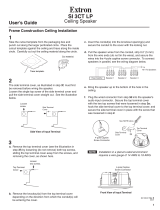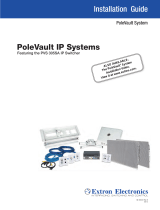
BCK SF 3CT LP and BCK SF 3C LP • Setup Guide
This setup guide contains installation information about the BCK SF 3CT LP, and BCK SF 3C LP. When fully assembled with
a DAK SF 3CT or DAK SF 3C they become a fully functioning SF 3CT LP or SF 3C LP Soundeld
®
XD full range speaker,
respectively. These speakers can be installed by a single trade installation procedure or by a multitrade installation procedure (see
the SF 3C LP and SF 3CT LP User Guide, available at www.extron.com, for details). The entire assembly is plenum rated.
WARNING: Potential risk of severe injury. Installation and service must be performed by authorized personnel only.
AVERTISSEMENT : Risque potentiel de blessure grave ou de mort. L’installation et l’entretien doivent être effectués
uniquement par un technicien qualié..
NOTE: Installation of conduit and conduit adapters must conform to all applicable building codes and local ordinances.
1. Disconnect power from all devices.
2. Verify the space where the system will be
installed — Ensure that there is sufficient clearance
above the ceiling tile for the unit to be installed.
3. Cut a hole for the speaker — Use the provided
cutout template to outline the hole to be cut in the
ceiling tile, as described below.
NOTE: For hard ceiling installations skip steps a
through e and use the cutout template to cut a
hole in the ceiling.
a. Remove the ceiling tile, and draw diagonal lines
across it from opposite corners to locate its center.
Mark the intersection where the lines cross.
b. Position the center hole of the cutout template
directly over the center of the tile, marked in
step2a.
c. Trace a circle on the ceiling tile around the cutout
template.
d. Cut out the circle traced in the ceiling tile.
e. Replace the ceiling tile in the ceiling.
4. Attach two V-rails and one C-ring acoss the tile and
above the hole cut in step 3, as described below.
NOTE: For hard ceiling installations:
• Fold one C-ring assembly in half and insert it
through the hole in the ceiling.
• Unfold the C-ring and center it over the hole
with the at side down.
• V-rails are not needed.
a. Assemble two V-rail half sections so that they
become one single piece by fitting the tab of one
end into the slot of the other end. Open the V-rail
until it locks together, as shown in the following
illustrations. Repeat this procedure for the other
V-rail.
b. Remove a ceiling tile adjacent to the tile with the
hole.
c. Place both assembled V-rails on the cut ceiling tile
and position them equally on either side of the hole.
The ends of the V-rails go over the ceiling grid.
d. Position the C-ring assembly on the two V-rails so
that the C-ring is centered over the hole.
C-ring
V
-rail
e. Secure the C-ring to the V-rails using two screws.
5. Route the speaker wires through the ceiling tile hole.
1

BCK SF 3CT LP and SF 3C LP • Setup Guide (Continued)
2
6. Configure the locking arms for thicker ceilings
(optional).
Three speaker locking arms, as shown below, are used
to secure the speaker to ceiling tiles up to 2.5 inches
(63 mm) thick. The locking arms are equipped with
removable inserts that accommodate ceiling tiles of up
to 1.5 inches
(3.81 mm) in thickness. For ceiling tiles thicker than
1.5 inches, the locking arm inserts must be removed.
To remove the inserts:
a. Using a screwdriver, rotate the locking arm so that
the insert can be accessed.
b. Use a small screwdriver to pry and separate the
insert from the locking arm, as shown below.
c. Repeat this process for the remaining two locking
arms.
d. Rotate all three locking arms back into the speaker.
7. Configure the cable/conduit access plate and
captive screw connector, as described below.
a. The cable/conduit access plate has one alternate
hole available covered by a knockout. This hole
may be used for loop out when using conduit. If this
knockout needs to be removed, do the following:
i. With the cable/conduit access plate still
attached to the speaker, place the tip of a
flat-head screwdriver against the notch of the
knockout.
ii. Lightly tap the screwdriver with a hammer to
remove the knockout.
b. Loosen the two side cable/conduit access plate
screws and remove the cover.
c. Configure the cable/conduit access plate.
• When not using conduit: Route the speaker
wires through the cable clamp.
• When using conduit: Remove the cable clamp
and install the conduit into the access plate
opening. Secure the conduit to the plate with
the locking nut and pull the speaker wires from
the conduit.
d. Strip 0.2 inches (5 mm) from the wire ends.
e. Use one of the following three methods to attach
the speaker wires to the captive screw connector
(depending on the configuration).
Wiring Multiple Speakers in Parallel
When a chain of speakers is wired this way,
disconnecting one speaker does not remove power
from the remaining speakers in the chain.
Speaker 1
Speaker 2
IN
–
LOOP
–
IN
+
LOOP
+
(Black)
(Red)
(Red)
(Red)
(Black)
(Black)
Power Amplifier
Speaker 1
Speaker 2
(Black)
(Red)
(Red)
(Black)
Power Amplifier
(Black)
(Red)
Speaker 1
(Red)
(Black)
Power Amplifier
IN
–
LOOP
–
IN
+
LOOP
+
IN
–
LOOP
–
IN
+
LOOP
+
IN
–
LOOP
–
IN
+
LOOP
+
IN
–
LOOP
–
IN
+
LOOP
+
Wiring Multiple Speakers Using Loop-through
When a chain of speakers is wired this way,
disconnecting one speaker removes power from all
downstream speakers.
Wiring a Single Speaker
1
2
3
Alternate
Knockout
Cable/conduit
Access Plate
Screws (2)
Cable
Clamp

3
ATTENTION:
• Do not tin the wire leads before installing
into the connector. Tinned wires are not
as secure in the connector and could be
pulled out.
• Ne pas étamer les conducteurs avant de
les insérer dans le connecteur. Les câbles
étamés ne sont pas aussi bien xés dans
le connecteur et pourraient être tirés.
• When connecting multiple speakers in
8-ohm mode, be sure that the combined
rated impedance does not equal a value
less than the minimum rated impedance of
the amplifier.
• Lors de la connexion de plusieurs
enceintes en mode 8ohm, assurez vous
que le niveau d’impédance combinée ne
soit pas équivalent à une valeur inférieure
à l’impédance minimum de l’amplificateur.
f. Insert the captive screw plug into the four-pole
receptacle of the speaker and screw it down.
Using a cable clamp:
Using a conduit adapter:
g. Replace the cable/conduit access plate and tighten
the two screws.
NOTE: The cable/conduit access plate can be
positioned in one of two ways depending on
the application. Flip the plate to the desired
position with the wire openings either on the
side or on the top of the speaker enclosure
before tightening the screws.
OR
h. Tighten the cable clamp if it was used.
8. Mount the speaker back can enclosure.
NOTE: For hard ceiling installations: Attach the
secondary support line (see step 9, page 4) prior
to mounting the speaker back can enclosure in
the
hard ceiling.
a. Insert the speaker through the bottom of the hole in
the ceiling tile that was cut in step 3 on page 1 with
the wires out of the way.
b. Clamp the back can to the C-ring using a Phillips
screwdriver to tighten the three locking arms to the
C-ring.
Flexible Conduit Adapter
Wiring Multiple Speakers in Parallel
When a chain of speakers is wired this way,
disconnecting one speaker does not remove power
from the remaining speakers in the chain.
Speaker 1
Speaker 2
IN
–
LOOP
–
IN
+
LOOP
+
(Black)
(Red)
(Red)
(Red)
(Black)
(Black)
Power Amplifier
Speaker 1
Speaker 2
(Black)
(Red)
(Red)
(Black)
Power Amplifier
(Black)
(Red)
Speaker 1
(Red)
(Black)
Power Amplifier
IN
–
LOOP
–
IN
+
LOOP
+
IN
–
LOOP
–
IN
+
LOOP
+
IN
–
LOOP
–
IN
+
LOOP
+
IN
–
LOOP
–
IN
+
LOOP
+
Wiring Multiple Speakers Using Loop-through
When a chain of speakers is wired this way,
disconnecting one speaker removes power from all
downstream speakers.
Wiring a Single Speaker
1
2
3
Number of
Wires per
Connection
Point
Maximum
Wire
Gauge
1 12 AWG
2 16 AWG
4 18 AWG

BCK SF 3CT LP and SF 3C LP • Setup Guide (Continued)
For information on safety guidelines, regulatory compliances, EMI/EMF compatibility, accessibility, and related topics,
see the Extron Safety and Regulatory Compliance Guide on the Extron website.
© 2019 Extron Electronics — All rights reserved. www.extron.com
All trademarks mentioned are the property of their respective owners.
Worldwide Headquarters: Extron USA West, 1025 E. Ball Road, Anaheim, CA 92805, 800.633.9876
68-2224-51 Rev A
02 19
4
NOTE: Each of the three locking arm screws
uses an Opti-Torque™ indicator. The
indicator releases a red plastic ring onto
the screwdriver once the screw is tightened
to the correct torque. Stop tightening
any further when this occurs to avoid
overtightening the locking arms to the C-ring.
ATTENTION:
• To avoid damaging the locking arms, do
not overtighten the three screws.
• Ne pas trop serrer les trois vis pour éviter
d’endommager les bras de verrouillage
de l’enceinte.
Tightening the locking arms into soft material:
Because fiberglass ceilings and other soft materials
are not as rigid as mineral tiles and other hard
materials, the Opti-Torque indicator should not to
be used as a tightening guide due to the risk of
overtightening.
ATTENTION:
• To avoid damaging or deforming soft
ceiling material, tighten the locking
arms to secure the speaker, but short of
causing the speaker to deform the at
mounting surface of the ceiling, as seen
from below.
• An de ne pas endommager ni d’altérer
un plafond souple, serrez les bras de
verrouillage pour sécuriser l’enceinte,
en veillant cependant à ce que l’unité
ne cause l’altération de la surface de
montage plane du plafond, comme
illustré ci-dessous.
X
9. If required, attach a secondary support line.
a. Connect a secondary support line to the support
loop on the back of the speaker enclosure, as
shown here.
Anchor end to suitable
secure points within the
solid and permanent
building structure.
ATTENTION:
• Do not allow any slack in the secondary
support line.
• Ne laissez pas de mou au niveau du filin de
sécurité secondaire.
b. Replace the adjacent tile that was removed in
step 4b on page 1.
10. Repeat steps for each speaker being installed.
The back cans are now ready for installation of the speaker
driver (DAK SF 3CT and DAK SF 3C).
/


